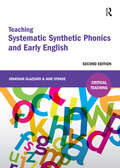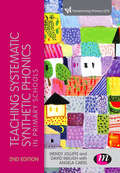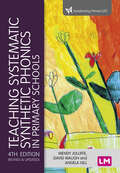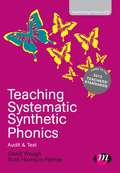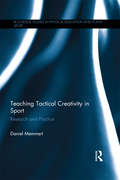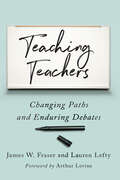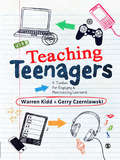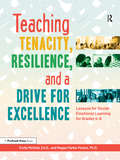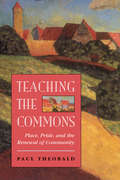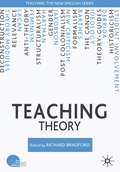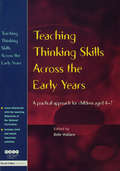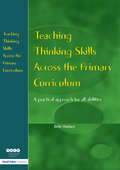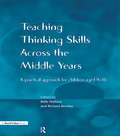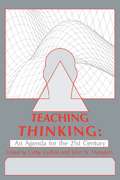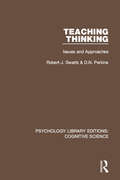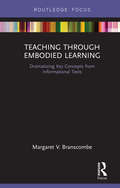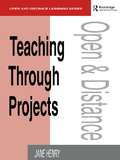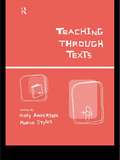- Table View
- List View
Teaching Systematic Synthetic Phonics and Early English (Critical Teaching)
by Jonathan Glazzard Jane StokoeThis is an essential guide to teaching primary English, with a focus on systematic synthetic phonics. The new edition has been fully revised and updated to reflect the structure, content and requirements of the national curriculum, and to include the latest policy context. Throughout, the range of underpinning literature has been expanded and there are completely new chapters on evidence based teaching in relation to phonics, reading for pleasure, and teaching English through texts. All the existing features have been retained, and each chapter now also includes: a section on integrating ICT extension questions to challenge M level readers sections on evidence-based practice to encourage critical reflection and debate.
Teaching Systematic Synthetic Phonics in Primary Schools (Transforming Primary QTS Series)
by David Waugh Angela Carss Wendy JolliffeThe government prioritizes systematic synthetic phonics as a key strategy in the teaching of reading and this text supports trainee teachers working towards primary QTS in how to use phonics effectively. The text begins by examining the central role of phonics in the teaching of reading, drawing on recent research and initiatives. It goes on to cover the essential knowledge trainees need to acquire themselves for the teaching of phonics to children. Accessible and relevant, the text uses case studies and useful research to support trainees in becoming competent and confident in the teaching of phonics. Supplement this text with the companion audit and test book: Teaching Systematic Synthetic Phonics Audit and Test About the Transforming Primary QTS series This series reflects the new creative way schools are begining to teach, taking a fresh approach to supporting trainees as they work towards primary QTS. Titles provide fully up to date resources focused on teaching a more integrated and inclusive curriculum, and texts draw out meaningful and explicit cross curricular links.
Teaching Systematic Synthetic Phonics in Primary Schools (Transforming Primary QTS Series)
by David Waugh Wendy Jolliffe Angela GillThe government prioritizes systematic synthetic phonics as a key strategy in the teaching of reading and this is your guide to teaching systematic synthetic phonics in primary schools. This text supports trainee teachers working towards primary QTS through the exploration of a range of aspects of phonics teaching. It gives a balance of research and practice and allows trainees to develop and in-depth understanding of what works in phonics teaching, and why. It begins with the subject knowledge that underpins effective teaching - key aspects of the alphabetic code from discriminating sounds and phonemes to teaching long vowel phonemes and their different spellings and pronunciations. It goes on to explore pedagogy from the early years to Key Stage 2 giving guidance on, among others, systematic progression, intervention and multi-sensory and interactive methods. The title includes a review of different popular phonics programmes, set against the DfE (2011) criteria for high-quality phonics teaching. This third edition has been updated in line with changes in primary education. A new section includes classroom case studies and lesson ideas for teachers to learn about best practice from other teachers.
Teaching Systematic Synthetic Phonics in Primary Schools (Transforming Primary QTS Series)
by David Waugh Wendy Jolliffe Angela GillThe government prioritizes systematic synthetic phonics as a key strategy in the teaching of reading and this is your guide to teaching systematic synthetic phonics in primary schools. This text supports trainee teachers working towards primary QTS through the exploration of a range of aspects of phonics teaching. It gives a balance of research and practice and allows trainees to develop and in-depth understanding of what works in phonics teaching, and why. It begins with the subject knowledge that underpins effective teaching - key aspects of the alphabetic code from discriminating sounds and phonemes to teaching long vowel phonemes and their different spellings and pronunciations. It goes on to explore pedagogy from the early years to Key Stage 2 giving guidance on, among others, systematic progression, intervention and multi-sensory and interactive methods. The title includes a review of different popular phonics programmes, set against the DfE (2011) criteria for high-quality phonics teaching. This third edition has been updated in line with changes in primary education. A new section includes classroom case studies and lesson ideas for teachers to learn about best practice from other teachers.
Teaching Systematic Synthetic Phonics in Primary Schools (Transforming Primary QTS Series)
by David Waugh Wendy Jolliffe Angela GillThe government prioritizes systematic synthetic phonics as a key strategy in the teaching of reading. This core text is your guide to teaching systematic synthetic phonics in primary schools. The book′s balance of research and practice and its focused approach enables you to develop an in-depth understanding of what works in phonics teaching, and why. It begins with the subject knowledge that underpins effective teaching and goes on to explore pedagogy from the early years to Key Stage 2. It includes guidance on systematic progression, intervention and multi-sensory and interactive methods. This 4th edition includes a new section ′Challenges in learning and teaching phonics′ supporting you to meet the individual needs of children.
Teaching Systematic Synthetic Phonics in Primary Schools (Transforming Primary QTS Series)
by David Waugh Wendy Jolliffe Angela GillThe government prioritizes systematic synthetic phonics as a key strategy in the teaching of reading. This core text is your guide to teaching systematic synthetic phonics in primary schools. The book′s balance of research and practice and its focused approach enables you to develop an in-depth understanding of what works in phonics teaching, and why. It begins with the subject knowledge that underpins effective teaching and goes on to explore pedagogy from the early years to Key Stage 2. It includes guidance on systematic progression, intervention and multi-sensory and interactive methods. This 4th edition includes a new section ′Challenges in learning and teaching phonics′ supporting you to meet the individual needs of children.
Teaching Systematic Synthetic Phonics: Audit and Test (Transforming Primary QTS Series)
by David Waugh Ruth Harrison-PalmerCan you demonstrate a clear understanding of systematic synthetic phonics? If you are training to be a primary school teacher you need to have, and to demonstrate, a clear understanding of systematic synthetic phonics to meet the Teachers' Standards. This companion text to the popular Teaching Systematic Synthetic Phonics in Primary Schools enables you to audit your knowledge, making you more aware of the subject and the areas in which you need to know more. In all chapters, self audits are accompanied by guidance on next steps for developing your knowledge. All chapters feature sections that link your learning to the classroom, showing you how to use your knowledge to teach phonics. Designed to help build your confidence and develop your knowledge of phonics, this text supports your development as an effective teacher of reading. This is a companion text to: Teaching Systematic Synthetic Phonics in Primary Schools Joliffe, Waugh and Carss David Waugh is Director on Primary PGCE at Durham University where he is also the subject leader for English. He has published extensively in Primary English. David is a former deputy head teacher, was Head of the Education department at University of Hull, and was Regional Adviser for ITT for the National Strategies from 2008 to 2010. Ruth Harrison-Palmer is a former acting head teacher. She has worked for the National Strategies and Cumbria Local Authority as a literacy consultant. Currently Ruth has a senior role in ITE at the University of Cumbria.
Teaching Tactical Creativity in Sport: Research and Practice (Routledge Studies in Physical Education and Youth Sport)
by Daniel MemmertCreativity is an essential component of sport performance. The player who can make decisions that are both unexpected – and therefore less easily predicted by his/her opponent – and appropriate is the player who is likely to be successful. In this ground-breaking new book Daniel Memmert explores the concept of tactical creativity, introducing a new theoretical framework based on extensive empirical research. He argues for the importance of encouraging divergent thinking abilities at an early age, and explains how tactical creativity sits alongside conventional approaches to 'teaching games for understanding'. The book outlines essential rules for environmental and training conditions, and suggests a wide range of game forms for teaching and coaching tactical creativity to children and young people. This is important to all students, researchers, coaches and teachers working in physical education, sports coaching, sport psychology or skill acquisition.
Teaching Teachers: Changing Paths and Enduring Debates
by James W. Fraser Lauren LeftyTeacher education in America has changed dramatically in the past thirty years—with major implications for how our kids are taught.As recently as 1990, if a person wanted to become a public school teacher in the United States, he or she needed to attend an accredited university education program. Less than three decades later, the variety of routes into teaching is staggering. In Teaching Teachers, education historians James W. Fraser and Lauren Lefty look at these alternative programs through the lens of the past. Fraser and Lefty explain how, beginning in 1986, an extraordinary range of new teaching programs emerged, most of which moved teacher education out of universities. In some school districts and charter schools, superintendents started their own teacher preparation programs—sometimes in conjunction with universities, sometimes not. Other teacher educators designed blended programs, creating collaboration between university teacher education programs and other parts of the university, linking with school districts and independent providers, and creating a range of novel options. Fraser and Lefty argue that three factors help explain this dramatic shift in how teachers are trained: an ethos that market forces were the solution to social problems; long-term dissatisfaction with the inadequacies of university-based teacher education; and the frustration of school superintendents with teachers themselves, who can seem both underprepared and too quick to challenge established policy. Surveying which programs are effective and which are not, this book also examines the impact of for-profit teacher training in the classroom. Casting light on the historical and social forces that led to the sea change in the ways American teachers are prepared, Teaching Teachers is a substantial and unbiased history of a controversial topic.
Teaching Tech Together: How to Make Your Lessons Work and Build a Teaching Community around Them
by Greg WilsonHundreds of grassroots groups have sprung up around the world to teach programming, web design, robotics, and other skills outside traditional classrooms. These groups exist so that people don't have to learn these things on their own, but ironically, their founders and instructors are often teaching themselves how to teach. There's a better way. This book presents evidence-based practices that will help you create and deliver lessons that work and build a teaching community around them. Topics include the differences between different kinds of learners, diagnosing and correcting misunderstandings, teaching as a performance art, what motivates and demotivates adult learners, how to be a good ally, fostering a healthy community, getting the word out, and building alliances with like-minded groups. The book includes over a hundred exercises that can be done individually or in groups, over 350 references, and a glossary to help you navigate educational jargon.
Teaching Tech-Savvy Kids: Bringing Digital Media Into the Classroom, Grades 5-12
by Jessica K. ParkerStudents are plugged in, powered up, and connected. Are you? The author gives teachers a deeper understanding of the dynamic potential for increasing student learning through digital media. Based on a three-year study of youth and their use of new media, this teacher-friendly resource includes: Descriptions of digital tools such as social networking platforms, YouTube, Wikipedia, virtual worlds, digital music, and more Vignettes about how young people use digital media Sidebars debunking common myths about technology Advice about navigating digital media for both novice and expert teachers Pedagogical implications and practices, including sample activities
Teaching Teenagers: A Toolbox for Engaging and Motivating Learners
by Warren Kidd Gerry CzerniawskiFor successful classroom teaching, your students need to be engaged and active learners. In this book, there is practical advice that is grounded in the realities of teaching in today′s classrooms on how to be an inspirational teacher and produce highly motivated students. This book contains 220 positive, practical teaching ideas that are relevant to both new and experienced classroom teachers. Contents cover: - teaching tools to inspire and captivate - motivation for learning - engaging learners - how to create a learning atmosphere - classroom management - cooperative learning - learning outside of the classroom - moving learners around the room - assessment for motivation and engagement - feedback and praise - using emerging technologies to engage - using homework - supporting learners in learning how to learn - challenging learners of all abilities With reference to reflective practice, best practice and Continuing Professional Development (CPD), this book provides essential support for trainee teachers, new teachers and experienced teachers looking to extend their repertoire. Warren Kidd is Senior Lecturer in Post Compulsory Education and Training at The Cass School of Education, University of East London. Gerry Czerniawski is Senior Lecturer in Secondary Social Science and Humanities Education at the Cass School of Education, University of East London.
Teaching Tenacity, Resilience, and a Drive for Excellence: Lessons for Social-Emotional Learning for Grades 4-8
by Emily Mofield Megan Parker PetersHow can we help students develop resilience to persevere in the face of setbacks? How can we ignite a drive that will inspire them to sustain effort even through difficulty? This book equips teachers to deliberately cultivate psychosocial skills, including self-awareness, problem solving to deal with setbacks, assertive interpersonal skills, and intellectual risk-taking. By teaching students to be aware of how their thoughts, emotions, and behaviors affect their pursuit of excellence, students can learn to tackle challenges and setbacks that they might experience as they reach to achieve. Lessons include engaging activities and curriculum connections, covering topics related to perfectionism, mindset, grit, stress, procrastination, social-emotional intelligence, and more. Grades 4-
Teaching That Changes Lives: 12 Mindset Tools for Igniting the Love of Learning
by Marilee G. AdamsBuilding on the success of her classic, bestselling book, Change Your Questions, Change Your Life, Marilee Adams shows how, by adopting a new mindset, teachers can rekindle their love of teaching and ignite their students with a love of learning.Teaching That Changes Lives is a transformational and practical guide that will enable teachers to make an authentic difference with their students and avoid succumbing to the myriad pressures and challenges of their jobs. Using the storytelling format that proved so successful in her previous book, Adams tells how Emma, a sixth-grade teacher on the verge of quitting her job, learns to cultivate what Adams calls the “Learner Mindset”— having the discipline, curiosity, and courage to consistently ask growth-oriented, open-minded questions of oneself and others—and to avoid the close-minded and critical “Judger Mindset.” Emma transforms her classroom, her relationships with her colleagues, and, most importantly, her students' eagerness for learning and achievement. Teaching is more than imparting facts and skills—it's preparing students for the test of life. Featuring an innovative, easy-to-follow workbook and access to a Learner Mindset online mini-course, this inspiring book will ensure that teachers and students alike become creative, resilient problem solvers, bridge builders, and lifelong learners.
Teaching The Commons: Place, Pride, And The Renewal Of Community
by Paul TheobaldReaching all the way back to the classical and medieval past, Teaching the Commons chronicles ideas and resulting policies that have shaped contemporary rural life and living in much of the industrial West. The book examines philosophical assumptions and charts their evolution into conventional wisdom about how human beings should meet their needs, govern themselves, and educate their children. Further, this book examines how policies emanating from these assumptions have slowly eroded the vitality of rural communities, finding that if there is sufficient interest in saving what is left of rural America, an educational agenda at the local level needs to be embraced by America's rural schools.Using concrete ideas generated in rural schools across the country, Teaching the Commons demonstrates that it is possible to simultaneously revitalize rural schools and communities. Through concerted curricular and pedagogical attention to place?the immediate locality?schools can contribute to rebuilding community in rural America on an educational foundation.Arguing that vital, self-governing communities rather than self-interested individuals represent the greatest hope for American democracy, Teaching the Commons lays out an institutional foundation that would turn the cultivation of civic virtue into an educational goal every bit as important and attainable as education for success in the economic market.
Teaching Theory
by Richard BradfordTeaching Theory offers a selection of essays on the pragmatics, benefits and shortcomings of Theory as a key aspect of literature teaching in universities. They range from reflective discussions of Theory as an intellectual challenge for undergraduates to accounts of the day-to-day problems of planning and teaching courses and implementing Theory.
Teaching Thinking Skills Across the Early Years: A Practical Approach for Children Aged 4 - 7
by Nicola Beverley Mike Carter Belle Wallace Lynne McClure Dorothy RickarbyThis book helps teachers incorporate problem-solving and thinking skills into the National Curriculum at the Foundation Phase and Key Stage 1, in line with QCA and DfES recommendations. It presents a range of activities for children aged 4-7 years, all of which have been tried and tested in classrooms. The ideas are cross-referenced with the Learning Objectives of the National Curriculum, and are enhanced with samples of children's work. It provides sections on the core subjects of literacy, numeracy and science, and ideas for project work across the curriculum. This book is aimed at teachers at the Foundation Phase and Key Stage 1. Teacher trainers, student teachers, teaching assistants, parents and all those working in early years settings will find it equally useful.
Teaching Thinking Skills Across the Primary Curriculum: A Practical Approach for All Abilities
by Belle WallaceThis book presents a practical and universal framework for the teaching of thinking skills and problem-solving across the primary curriculum, using examples of topics from the National Curriculum, classroom techniques, and tried-and-tested activities which systematically develop pupils' thinking and problem-solving skills. While accommodating the need of all learners to develop effective thinking skills, the book also caters to the need to differentiate learning activities to extend the more able learners. Written by a team of teachers who recognize the day-to-day problems that face their colleagues in the classroom, this accessible, jargon-free book will be welcomed by teachers, SENCOs and ABCOs alike.
Teaching Thinking Skills across the Middle Years: A Practical Approach for Children Aged 9-14
by Richard Bentley Belle WallaceThis book presents a practical framework for the teaching of thinking skills and problem-solving with children across Key Stages 2 and 3. Using examples of topics from the National Curriculum, teachers are presented with classroom techniques and activities, which systematically develop these skills. While accommodating the needs of all learners, the book caters for the need to differentiate learning activities to extend the more able learners. Included are suggested activities for developing thinking and problem-solving skills relating to the National Numeracy Curriculum, the National Literacy Strategy and the National Science Curriculum. The book also includes activities to support the development of thinking and problem-solving skills in information communication technology (ICT), models of successful practice, and photocopiable activities. The skills and strategies suggested all derive from real classrooms and teachers and as such are practical and useful. There is clear guidance on adopting certain teaching techniques, lesson planning and organization. This book will be useful for teachers and headteachers working at Key Stages 2 and 3, all SENCOs and Advisory Teachers.
Teaching Thinking Skills: Theory & Practice (Source Books on Education #28)
by Carol Rhoder Joyce N. FrenchFirst Published in 1992. Routledge is an imprint of Taylor & Francis, an informa company.
Teaching Thinking: An Agenda for the Twenty-first Century
by Cathy Collins John N. MangieriComprehensively addressing the development of thinking from a wide variety of perspectives, this volume presents original work from cognitive psychologists, curriculum specialists, federal government and business leaders, politicians, educational theorists, and other prominent figures specializing in this complex field. These experts provide directives for teacher education, textbook development, classroom activities, administrative policies, publication procedures, business connections, community education strategies, and whole school projects as sample plans of action. Designed to spark adoptions of the solutions it proposes, this book suggests significant steps that can be taken to move toward more advanced thinking instruction in our educational systems.
Teaching Thinking: Issues and Approaches (Psychology Library Editions: Cognitive Science)
by Robert J. Swartz D.N. PerkinsOriginally published in 1990, this title attempts to provide for the educational practitioner an overview of a field that responded in the 1980s to a major educational agenda. This innovative ‘agenda’ called for teaching students in ways that dramatically improved the quality of their thinking. Its context is a variety of changes in education that brought the explicit teaching of thinking to the consciousness of more and more teachers and administrators.
Teaching Through Embodied Learning: Dramatizing Key Concepts from Informational Texts
by Margaret V. BranscombeTeaching Through Embodied Learning positions drama as an under-utilised but valuable tool for enhancing the learning of information in primary science texts. Creating a ‘tableau’ is an established drama practice for exploring key moments in fiction texts and historical events but less frequently applied with non-fiction texts. Based on doctoral research that studied the impact of having students create a tableau in response to reading informational texts about the solar system, it presents the idea that using drama with informational texts causes students to read purposefully and respond aesthetically; thus, positively impacting reading behaviour, comprehension and social behaviour. The book addresses the neglect of the body in learning and positions this against a narrow curriculum that is focused on print and ‘seated learning’. Within a current context, it acknowledges increasing concerns by educational leaders and academics of the need for a ‘broad and balanced curriculum’ and pedagogical practice. In support of these concerns, the book places tableau as an embodied learning mode that broadens curriculum experience and discusses recent research that highlights the role of drama and the body in enhancing cognition. Teaching Through Embodied Learning will be essential reading for academics, researchers and post-graduate students in the fields of education and drama education. It will also greatly appeal to teacher educators, drama teachers and academics in literacy departments.
Teaching Through Projects (Open and Flexible Learning Series)
by Henry, JaneDesigned for those developing open or distance learning materials, this guide describes various kinds of projects along with the appropriate tuition methods, assessment procedures and the expected learning outcome. The tutor's role as supervisor is examined, as are grading and assessment methods.
Teaching Through Texts: Promoting Literacy Through Popular and Literary Texts in the Primary Classroom
by Holly Anderson Morag StylesFirst published in 1999. Routledge is an imprint of Taylor & Francis, an informa company.
